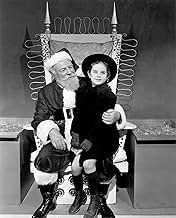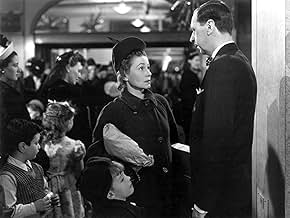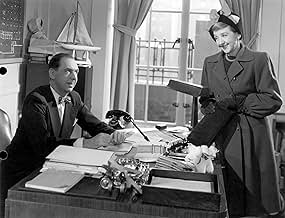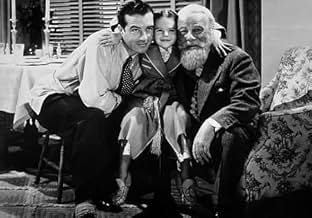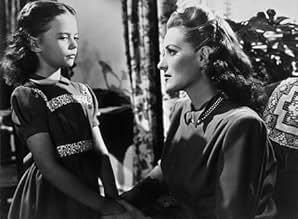AVALIAÇÃO DA IMDb
7,9/10
58 mil
SUA AVALIAÇÃO
Quando um velho simpático que diz ser Papai Noel é tomado por louco, um jovem advogado decide defendê-lo, argumentando em tribunal que ele é o real.Quando um velho simpático que diz ser Papai Noel é tomado por louco, um jovem advogado decide defendê-lo, argumentando em tribunal que ele é o real.Quando um velho simpático que diz ser Papai Noel é tomado por louco, um jovem advogado decide defendê-lo, argumentando em tribunal que ele é o real.
- Direção
- Roteiristas
- Artistas
- Ganhou 3 Oscars
- 10 vitórias e 1 indicação no total
Jack Albertson
- Post Office Mail Sorter Next to Lou
- (não creditado)
Harry Antrim
- Mr. R.H. Macy
- (não creditado)
Arline Bletcher
- Courtroom Spectator
- (não creditado)
Lela Bliss
- Mrs. Shellhammer
- (não creditado)
Symona Boniface
- Courtroom Spectator
- (não creditado)
Walden Boyle
- Judge's Clerk
- (não creditado)
Kevin Burke
- Child on Santa's Lap
- (não creditado)
Dorothy Christy
- Secretary
- (não creditado)
Dick Cogan
- Department Store Head
- (não creditado)
- Direção
- Roteiristas
- Elenco e equipe completos
- Produção, bilheteria e muito mais no IMDbPro
Avaliações em destaque
The remakes just don't carry the magic of the original, and what a cast we find in the original, starting with the beautiful Maureen O'Hara and the (then) child star Natalie Wood. Edmund Gwinn is perfect as Santa Claus, who appears on the scene when the Macy's Santa shows up drunk for the Thanksgiving Day Parade.
There are dozens of small comedic touches in the film, such as Santa sending customers to other stores when Macy's doesn't have what they need, and then the rivalry between Macy's and Gimball's when they copy the tactic.
Of course, the big payoff is the courtroom scenes, which just get funnier and funnier. This is one of the true Christmas Classics. Watch and enjoy. :-)
There are dozens of small comedic touches in the film, such as Santa sending customers to other stores when Macy's doesn't have what they need, and then the rivalry between Macy's and Gimball's when they copy the tactic.
Of course, the big payoff is the courtroom scenes, which just get funnier and funnier. This is one of the true Christmas Classics. Watch and enjoy. :-)
What's wonderful about 'Miracle On 34th Street (1947)' - and this isn't something I realised until after it had finished - is that it never actually provides a definitive answer as to whether Kris Kringle really is the Santa Claus. Personally, I took it as fact from the moment he walked into frame, but I'm pretty sure that was due to my preconceptions surrounding the plot of the picture (Santa goes to court to prove his existence). Thinking back, I had no definitive reason to think that. The absolute ambiguity of the film's central dilemma is brilliant because it forces the viewer to engage with the question that's on almost every characters' lips: is this the real Santa or is it just a kind old man who thinks he's the real Santa? In turn, this allows the movie's theme of belief to transcend its boundaries and truly take root in the audience. Whether you choose to believe in Santa, whether you choose to have faith in him, whether you choose to accept the unacceptable is entirely up to you. As such, it's that much more magical if you do. It's really impressive that the picture can actually use its ambiguity to this effect, especially that it can do so while remaining wholesome and sincere throughout. This charming Christmas tale is enjoyable from beginning to end and it holds up remarkably well seventy-five years after its initial release. It's a delightful experience overall.
The movie starts out in a festive atmosphere. It is Thanksgiving and the employees of Macy's department store are busy with preparations for the annual Thanksgiving day parade. Doris. Walker (Maureen O'Hare) is in charge of the parade. She anxiously hires Kris Kringle (Edmund Gwenn) to replace the man she hired to play Santa Claus when she discovers the original Santa is too intoxicated to even get on the float. Kris does such a good job that Mrs. Walker asks him to stay on in the role and be the department store's Santa. She soon has serious doubts about her decision when she discovers that her new Santa really believes he is Santa Claus.
Mrs. Walker is working, single mother, who works for Macy's Department Store in New York City. Natalie Wood plays her daughter, Susan. As the result of a failed Marriage, Doris raises her daughter to accept reality. There is no room for fantasy or make believe in her life. Susan is a quiet, child who acts more like a grown up than a 6 year old. She has difficulty using her imagination, and has become just as skeptical as her mother.
Since Kris, believes that "the important thing is to make children happy," winning the affection of Susan and her mother is his main objective.
Whether or not Kris is the real Santa Claus, there is no doubt that he seem to have an influence on almost everyone he meets--except for Macy's staff psychologist .Mr. Sawyer believes that Kris is delusional, and has him committed to thrown into a mental institution. In order to get out, Kris must face a court hearing, where not only is his sanity questioned, but the state of New York will decide if there really is a Santa Claus. Fred Gailey (played by John Payne) a neighbor of Doris Susan Walker agrees to represent Kris. The predictable end to the story is that Fred and Doris become attracted to each other, and as Fred works hard to secure Kris' freedom, Doris finds herself not only believing in Kris, but also in believing in fantasy.
Maureen O'Hara portrays Doris Walker with poise and sophistication. Although the movie is over 55 years old, the idea of a single working mom trying to raise her daughter after a bitter divorce, tells a story that is relevant by today's standards. Natalie Wood does such a good job at playing as the bright six year old, Susan, that you can almost imagine her going straight from being a baby to being an adult. John Payne, as Fred Gailey, predictably plays the handsome attorney who falls in love with Mrs. Walker. Even though it seems a bit unbelievable, this movie is all about fantasy, so we'll allow a bit of romance. Finally, Edmund Gwenn's portrayal of Santa Claus is so believable, that you almost believe that truly is the jolly old elf himself!
This reviewer would give the movie a 5 out of 5 rating. It is a Christmas classic that will be remembered for years to come as one of the best Christmas movies ever filmed. The message of the movie is not about the real meaning of Christmas, nor is it about the commercialism that has overshadowed the holiday for years. The message of the movie is that make believe and fantasy play an important role in our live. Without them we would have no basis for our hopes and dreams
Mrs. Walker is working, single mother, who works for Macy's Department Store in New York City. Natalie Wood plays her daughter, Susan. As the result of a failed Marriage, Doris raises her daughter to accept reality. There is no room for fantasy or make believe in her life. Susan is a quiet, child who acts more like a grown up than a 6 year old. She has difficulty using her imagination, and has become just as skeptical as her mother.
Since Kris, believes that "the important thing is to make children happy," winning the affection of Susan and her mother is his main objective.
Whether or not Kris is the real Santa Claus, there is no doubt that he seem to have an influence on almost everyone he meets--except for Macy's staff psychologist .Mr. Sawyer believes that Kris is delusional, and has him committed to thrown into a mental institution. In order to get out, Kris must face a court hearing, where not only is his sanity questioned, but the state of New York will decide if there really is a Santa Claus. Fred Gailey (played by John Payne) a neighbor of Doris Susan Walker agrees to represent Kris. The predictable end to the story is that Fred and Doris become attracted to each other, and as Fred works hard to secure Kris' freedom, Doris finds herself not only believing in Kris, but also in believing in fantasy.
Maureen O'Hara portrays Doris Walker with poise and sophistication. Although the movie is over 55 years old, the idea of a single working mom trying to raise her daughter after a bitter divorce, tells a story that is relevant by today's standards. Natalie Wood does such a good job at playing as the bright six year old, Susan, that you can almost imagine her going straight from being a baby to being an adult. John Payne, as Fred Gailey, predictably plays the handsome attorney who falls in love with Mrs. Walker. Even though it seems a bit unbelievable, this movie is all about fantasy, so we'll allow a bit of romance. Finally, Edmund Gwenn's portrayal of Santa Claus is so believable, that you almost believe that truly is the jolly old elf himself!
This reviewer would give the movie a 5 out of 5 rating. It is a Christmas classic that will be remembered for years to come as one of the best Christmas movies ever filmed. The message of the movie is not about the real meaning of Christmas, nor is it about the commercialism that has overshadowed the holiday for years. The message of the movie is that make believe and fantasy play an important role in our live. Without them we would have no basis for our hopes and dreams
This is certainly a lovely warmhearted movie, but since other reviewers have described the plot in detail, I'll move on to other topics.
I love movies like this for the insight they provide into the customs of a lost era. Watch the clothing - everybody is so dressed up! - women in dresses, gloves, and hats, men in hats and suits. Notice that when O'Hara enters a room filled with Macy's executives, even though they are the bosses and she is lower management, they all stand up instantly.
The social satire, most on display in the courtroom scenes, also is very 1940s. Apparently audiences of that era took a kind of genial corruption in the judicial system in stride. Business leaders, like "Mr. Macy" were expected to be sharp and profit-oriented, but also decent people like the rest of us. It's a much more nuanced view than the "businessman as criminal villain" so common in today's movies.
The character played by Maureen O'Hara probably needs explanation for modern viewers. Late 1940s audiences knew that the social and economic situation of a divorced working woman with a child was much more precarious than it is now. Divorce was still somewhat shocking - this is brought out neatly in the movie when her would-be lover does a double take when he learns from her daughter about the divorce - he probably had assumed she was a war widow. Divorced moms were still rare in the middle classes. Society universally agreed that women should stay home to raise their children. Economically, women in management positions were still very rare, couldn't expect promotion, and were last hired, first fired. I think O'Hara's performance brings out these qualities in a way that the audience of the 1940s would have understood easily. The character's stiffness, fear of losing control, and anxiety about her job make a great deal of sense. It would have been nice to see a few scenes showing her loosening up, perhaps at dinner with her boyfriend; no doubt those got left on the cutting room floor.
I really like the scene where Santa talks to the little Dutch orphan. First, this scene also must have resonated with the audience; in 1947 the western European countries had only started to recover from World War II, and probably many Americans were familiar with the idea of adopting a war orphan, just as many sent CARE packages. Second, by making Santa fluent in Dutch, the writer cleverly left the viewer thinking that hey, he might really be Santa Claus (isn't Santa Claus fluent in all languages)?
Some reviewers don't like the acting and think that modern actors are "better". I think the older actors aren't better or worse, just different. The audiences of the 1940s expected a certain style of acting, and the directors and actors gave that to them. Then as now, Hollywood paid top dollar and got very talented people, but like all of us they were shaped by their own time and place, more particularly the requirement to make movies that audiences would like. Move Maureen O'Hara to 2004, or Tom Cruise to 1947, and you'd see them acting in the style of that decade.
I love movies like this for the insight they provide into the customs of a lost era. Watch the clothing - everybody is so dressed up! - women in dresses, gloves, and hats, men in hats and suits. Notice that when O'Hara enters a room filled with Macy's executives, even though they are the bosses and she is lower management, they all stand up instantly.
The social satire, most on display in the courtroom scenes, also is very 1940s. Apparently audiences of that era took a kind of genial corruption in the judicial system in stride. Business leaders, like "Mr. Macy" were expected to be sharp and profit-oriented, but also decent people like the rest of us. It's a much more nuanced view than the "businessman as criminal villain" so common in today's movies.
The character played by Maureen O'Hara probably needs explanation for modern viewers. Late 1940s audiences knew that the social and economic situation of a divorced working woman with a child was much more precarious than it is now. Divorce was still somewhat shocking - this is brought out neatly in the movie when her would-be lover does a double take when he learns from her daughter about the divorce - he probably had assumed she was a war widow. Divorced moms were still rare in the middle classes. Society universally agreed that women should stay home to raise their children. Economically, women in management positions were still very rare, couldn't expect promotion, and were last hired, first fired. I think O'Hara's performance brings out these qualities in a way that the audience of the 1940s would have understood easily. The character's stiffness, fear of losing control, and anxiety about her job make a great deal of sense. It would have been nice to see a few scenes showing her loosening up, perhaps at dinner with her boyfriend; no doubt those got left on the cutting room floor.
I really like the scene where Santa talks to the little Dutch orphan. First, this scene also must have resonated with the audience; in 1947 the western European countries had only started to recover from World War II, and probably many Americans were familiar with the idea of adopting a war orphan, just as many sent CARE packages. Second, by making Santa fluent in Dutch, the writer cleverly left the viewer thinking that hey, he might really be Santa Claus (isn't Santa Claus fluent in all languages)?
Some reviewers don't like the acting and think that modern actors are "better". I think the older actors aren't better or worse, just different. The audiences of the 1940s expected a certain style of acting, and the directors and actors gave that to them. Then as now, Hollywood paid top dollar and got very talented people, but like all of us they were shaped by their own time and place, more particularly the requirement to make movies that audiences would like. Move Maureen O'Hara to 2004, or Tom Cruise to 1947, and you'd see them acting in the style of that decade.
A wholesome and magical film that captures the goodwill and essence of Christmas. A well made production. A good balance was struck between the magical nature of Kris Kringle and reality. This film warms the heart, encourages your imagination and respects your intelligence all at the same time. Interesting and fascinating from start to finish. Some great performances to bring this classic film to life.
Você sabia?
- CuriosidadesIn the untranslated dialogue with the Dutch girl, Kris asks her what she wants for Christmas. She says she wants nothing, telling him she got her gift by being adopted by her new mother.
- Erros de gravaçãoKris claims that John Quincy Adams' Vice-President was Daniel D. Tompkins; actually, it was John C. Calhoun. Tompkins served under James Monroe from 1817-1825. The confusion likely occurred because Adams was the 6th President, whereas Tompkins was the 6th Vice-President, as Thomas Jefferson and James Madison had three Vice-Presidents between them.
- Citações
Mr. Shellhammer: But... but maybe he's only a little crazy like painters or composers or... or some of those men in Washington.
- Cenas durante ou pós-créditosThe film's credits do not contain the standard "All characters and events are fictional..." disclaimer, leaving many people to believe that this was a true story.
- Versões alternativasAlso available in two computer colorized versions. The film was first colorized in 1985 by Color Systems Technology, Inc. and again in 2006 by Legend Films using much-improved technology. Prints came with a disclaimer: "It has been altered without the participation of the principal director, screenwriter and other creators of the original film."
- ConexõesFeatured in The Screen Writer (1950)
- Trilhas sonorasJingle Bells
(1857) (uncredited)
Written by James Pierpont
Played at the announcement of the parade
Played occasionally in the score
Sung a cappella a bit by Percy Helton and later by Jack Albertson
Principais escolhas
Faça login para avaliar e ver a lista de recomendações personalizadas
- How long is Miracle on 34th Street?Fornecido pela Alexa
Detalhes
- Data de lançamento
- País de origem
- Idiomas
- Também conhecido como
- Milagre na Rua 34
- Locações de filme
- 24 Derby Road, Port Washington, Long Island, Nova Iorque, EUA(Susan's dream house)
- Empresa de produção
- Consulte mais créditos da empresa na IMDbPro
Bilheteria
- Faturamento bruto mundial
- US$ 3.851
- Tempo de duração
- 1 h 36 min(96 min)
- Cor
- Proporção
- 1.37 : 1
Contribua para esta página
Sugerir uma alteração ou adicionar conteúdo ausente






